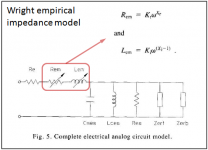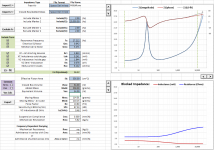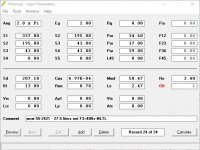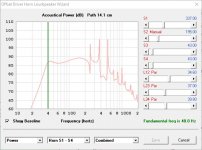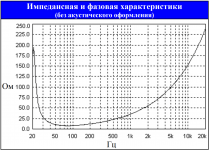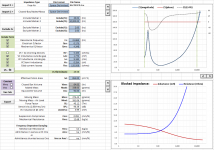Yeah, looks like the Wright model is purely empirical in nature so doesn't have any sort of direct mapping to the physically based Semi-Le model. You won't be able to match the frequency dependent inductance and resistance parameters, but you can still get a reasonable least-squares fit to the magnitude of the Wright blocked impedance model. The attached spreadsheet should do the trick, or at least be a good starting point for you....Is there a fairly easy way to translate from the Wright parameters to the semi-inductance parameters given in your spreadsheet, or are the models just to different to be able to do so?
Attachments
Problem files as requested:
The tweeter file says "not enough columns"
The two other are the error I mentioned.
Excel 2010, all three options installed. Rebooted.
For a standard file format, quite a pain as it seems every tool has slightly different preferences. I'm glad I used to just hire the programmers.
The tweeter file says "not enough columns"
The two other are the error I mentioned.
Excel 2010, all three options installed. Rebooted.
For a standard file format, quite a pain as it seems every tool has slightly different preferences. I'm glad I used to just hire the programmers.
Thanks for posting the *.zma files you were having issues with.
The "Seas27TBCD" is TAB delimited.
Once you choose TAB delimited from the file format drop down list, it will load fine.
The other two files having leading spaces before column one. Version 3 of the spreadsheet was supposed to have been updated to handle this, but looking at the code now, I see the part to trim off the leading spaces is not active...not sure why. Sorry about that, attached is a Beta version with that fixed. Let me know if you have any other issues.
I am working on an update that will allow import of UNIX/LINUX formatted text files (ie no carriage returns) and address some of the issues mentioned in posts 73-78 concerning decimal separators.
The "Seas27TBCD" is TAB delimited.
Once you choose TAB delimited from the file format drop down list, it will load fine.
The other two files having leading spaces before column one. Version 3 of the spreadsheet was supposed to have been updated to handle this, but looking at the code now, I see the part to trim off the leading spaces is not active...not sure why. Sorry about that, attached is a Beta version with that fixed. Let me know if you have any other issues.
I am working on an update that will allow import of UNIX/LINUX formatted text files (ie no carriage returns) and address some of the issues mentioned in posts 73-78 concerning decimal separators.
Attachments
Seems to work now!
The RSS265 is a very low inductance woofer, so I'll go capture the files for the Titanic woofer, which is much higher inductance and where HornRes showed a different result.
I of course, let my WT-II do the work, so I don't have .zma file saved for added mass. I will then retest my little RSS150 drivers to see what the difference is. Curious if it would have a measurable effect on the passive crossover. I might then make a new comparison with a Zobel in the circuit. As I tent to aluminum cones, One is almost always included to assist with suppressing breakup.
Should keep me busy for the day.
The RSS265 is a very low inductance woofer, so I'll go capture the files for the Titanic woofer, which is much higher inductance and where HornRes showed a different result.
I of course, let my WT-II do the work, so I don't have .zma file saved for added mass. I will then retest my little RSS150 drivers to see what the difference is. Curious if it would have a measurable effect on the passive crossover. I might then make a new comparison with a Zobel in the circuit. As I tent to aluminum cones, One is almost always included to assist with suppressing breakup.
Should keep me busy for the day.
mcm 55-2421
Hi,
I need help to calculate the Semi-LE for this driver. I would figure the Lossy LE in the HR (1KHz) would not give the accurate result. Thanks,
https://www.farnell.com/datasheets/2329567.pdf
Hi,
I need help to calculate the Semi-LE for this driver. I would figure the Lossy LE in the HR (1KHz) would not give the accurate result. Thanks,
https://www.farnell.com/datasheets/2329567.pdf
Attachments
Trying to get a better model of intended tapped horn with the locally available driver, I decided to derive semi-inductance parameters with the spreadsheet. Only I do not have the driver (yet). I only have the datasheet from the manufacturer which also includes impedance curve graph as an image. Using a web-app, I digitized the graph back to a dataset and tried to import the data into the spreadsheet.
But when I try to do this, I get "Subscript out of range" error. Before this, i was getting "Type miscmatch" error, so i figured that i need to add a third column (phase) with zeroes. Anyway, i will attach the text file with impedance data and the image i used to get those data.
Is the problem with the data being not dense enough? Or am I doing something wrong?
BTW, decimal separator in my country is a coma (",").
But when I try to do this, I get "Subscript out of range" error. Before this, i was getting "Type miscmatch" error, so i figured that i need to add a third column (phase) with zeroes. Anyway, i will attach the text file with impedance data and the image i used to get those data.
Is the problem with the data being not dense enough? Or am I doing something wrong?
BTW, decimal separator in my country is a coma (",").
Attachments
My bad. The data i extracted from the graph image was incorrect. WebPlotDigitizer allows interpretation of the plot as a regular scale and as a log scale. I accidentally checked 'log scale' option on both axis, although log scale is only the X axis. Also, the data on the graph is only available down to 20Hz. So i extrapolated it down to about 10Hz.
Got this graph into the spreadsheet:

And got the Semi-Le params.
Thank you, bolserst!
Got this graph into the spreadsheet:
And got the Semi-Le params.
Thank you, bolserst!
I'm having trouble loading the impedance file in the spreadsheet, like StabMe i created it using WebPlotDigitizer but i'm getting "Error 13 Type Mismatch" when trying to import it. I tried with and without adding the phase and also tried replacing the commas with dots. "Space Delimited" is selected in the spreadsheet.

Attachments
I'm not sure exactly what compatibility issues you are having.
When you tried replacing the commas with dots in the data file, did you also change decimal separator for Windows? https://www.softwareok.com/?seite=faq-Windows-7&faq=78
More details here: Post #75
I used the data file you attached to create both a space delimited *.txt file and a comma delimited *.csv file(zipped) and both work fine with Excel installation using "." as the decimal separator.
Attached also are the exported TSP file and Hornresp driver file.
When you tried replacing the commas with dots in the data file, did you also change decimal separator for Windows? https://www.softwareok.com/?seite=faq-Windows-7&faq=78
More details here: Post #75
I used the data file you attached to create both a space delimited *.txt file and a comma delimited *.csv file(zipped) and both work fine with Excel installation using "." as the decimal separator.
Attached also are the exported TSP file and Hornresp driver file.
Attachments
Apologies for the extremely tardy reply...in my defense I have not been receiving email notification consistently to threads I follow after the forum platform migration.
No, unfortunately Libre office does not provide the functionality of Excel required to easily port it over.
I have been playing with Python lately, and may at some point post a standalone tool.
In the mean time, if there is a particular driver you need data for, you can post here(or send via IM) and I would be happy to create the parameter files for you.
Another alternative is to consider using the web based utility that was created by Claus Futtrup and Jeff Candy. It requires testing with added mass, not sealed enclosure.
https://www.diyaudio.com/community/threads/speakerbench.376463/post-6769863
*** Note the link to youtube tutorial in Post#14.
No, unfortunately Libre office does not provide the functionality of Excel required to easily port it over.
I have been playing with Python lately, and may at some point post a standalone tool.
In the mean time, if there is a particular driver you need data for, you can post here(or send via IM) and I would be happy to create the parameter files for you.
Another alternative is to consider using the web based utility that was created by Claus Futtrup and Jeff Candy. It requires testing with added mass, not sealed enclosure.
https://www.diyaudio.com/community/threads/speakerbench.376463/post-6769863
*** Note the link to youtube tutorial in Post#14.
Hello Bolsert,In the mean time, if there is a particular driver you need data for,
Thanks for your feedback, there is no particular driver I'm interested on, I was needing to use the file to check the FreeCAD models and see if they were exporting data correctly, to do that I get some semi-le values from Brian Steele website.
I don't build loudspeakers too often, I do for myself as hobbyist, and I use local brands, so, the probability you having them available in your database is very low:
Some Brazilian brands are: Snake (phased out), Oversound, Eros, Triton, etc
The only brand you could have is Selenium / JBL, but in Brazil now, they are focused on CAR market and driver available aren't good for PA. They phased out the major part of their portfolio, unfortunately.
Web-based tool or stand alone one would be really nice. The FreeCAD I made has Python script to export data.
Did you check with David if he could append the stand alone tool directly on hornresp? this would also be really nice for the users.
Regards,
Hi all,I'm not sure exactly what compatibility issues you are having.
When you tried replacing the commas with dots in the data file, did you also change decimal separator for Windows? https://www.softwareok.com/?seite=faq-Windows-7&faq=78
More details here: Post #75
I used the data file you attached to create both a space delimited *.txt file and a comma delimited *.csv file(zipped) and both work fine with Excel installation using "." as the decimal separator.
Attached also are the exported TSP file and Hornresp driver file.
If for instance, I were to use the Semi Le values calculated here for the 15DS115 in Hornresp. Is it appropriate to still activate the Lossy Le function or is that unnecessary since the Semi Le values have already been applied?
Many thanks,
If the Lossy-Le function is activated the Semi-Le values are ignored. You can only use one or the other.
If Sem-Le is active, the Le label will be green. If Lossy-Le is active the Le label will be red.
See Change 5 description here: https://www.diyaudio.com/community/threads/hornresp.119854/post-5404994
Lossy-Le should only be used if Semi-Le parameters are not available.
Here is a post showing comparisons to measurements for Traditional, Lossy-Le, and Semi-Le Models.
You can see that the Semi-Le results are easily the best match to measurements.
https://www.diyaudio.com/community/threads/hornresp.119854/post-5408931
If Sem-Le is active, the Le label will be green. If Lossy-Le is active the Le label will be red.
See Change 5 description here: https://www.diyaudio.com/community/threads/hornresp.119854/post-5404994
Lossy-Le should only be used if Semi-Le parameters are not available.
Here is a post showing comparisons to measurements for Traditional, Lossy-Le, and Semi-Le Models.
You can see that the Semi-Le results are easily the best match to measurements.
https://www.diyaudio.com/community/threads/hornresp.119854/post-5408931
Last edited:
- Home
- Loudspeakers
- Subwoofers
- Semi-Le_Calc: Calculator for Advanced Inductance Model Incorporating Semi-Inductance
